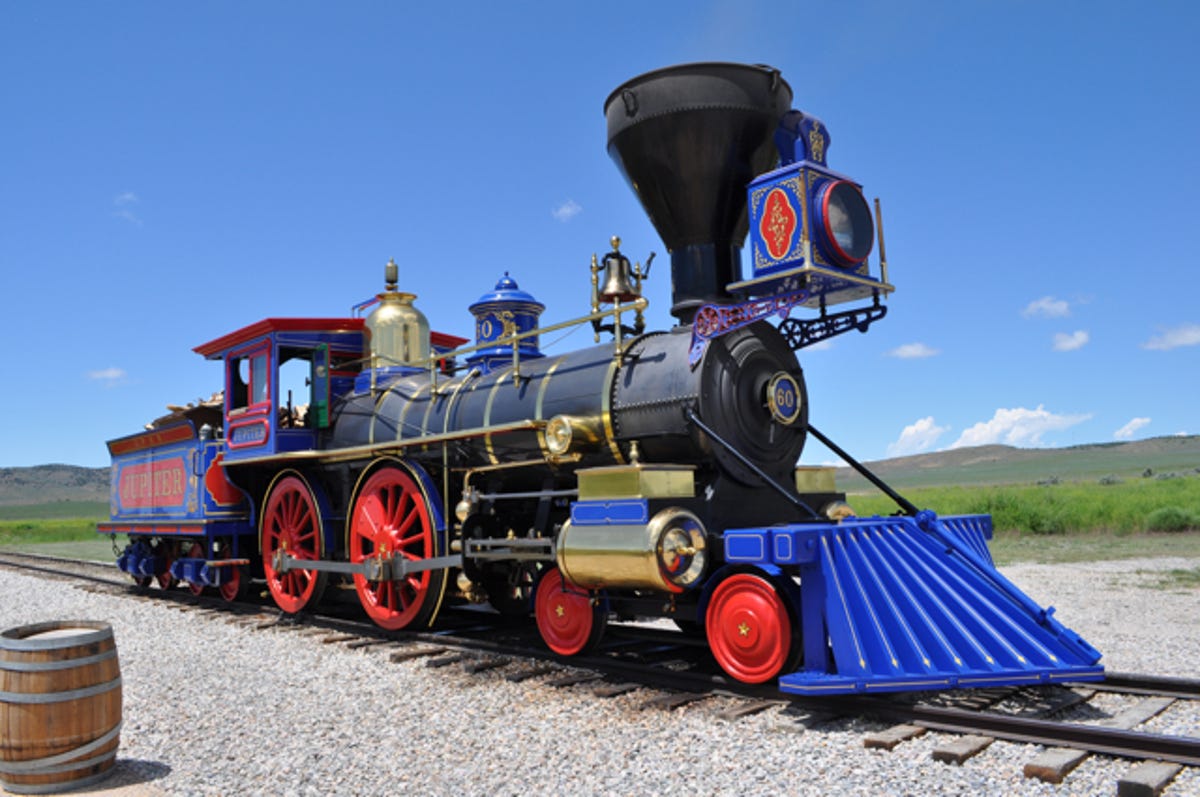Photos: The Transcontinental Railroad's Golden Spike
On Road Trip 2009, CNET News reporter Daniel Terdiman encountered the spot where the Union Pacific and Central Pacific railroads met, finally forming a complete Transcontinental Railroad.<br>

Jupiter
Driving through open country on a gorgeous Utah day on the north side of the Great Salt Lake as part of his Road Trip 2009, CNET News reporter Daniel Terdiman discovered the Golden Spike National Historic Site.
There, on May 10, 1869, the final tie was laid and the final spike--the "golden" spike--was driven in to create the Transcontinental Railroad. It was the meeting of the Central Pacific Railroad out of Sacramento, Calif., and the Union Pacific Railroad out of Omaha, Neb.
With that final spike, the railroad was completed, and for the first time, it was possible for a single train to cross (most of) the country.
"Two locomotives--Central Pacific's Jupiter and Union Pacific's No. 119--pulled up to the one rail gap left in the track," reads a National Park Service brochure. "After a golden spike was symbolically tapped, a final iron spike was driven to connect the railroads."
Click here for the entire Road Trip 2009 package.
Union Pacific
Union Pacific train No. 119, which met the Central Pacific's Jupiter at Promontory Summit, as Congress decreed the site be called. No. 119 had crossed 1,086 miles to get to the first-ever meeting point of the two railroads.
Click here for the full Road Trip 2009 package.
Jupiter head-on
A head-on look at the Central Pacific Railroad's Jupiter, the first train from that railroad to meet up with track from the Union Pacific, a joining that formed the Transcontinental Railroad at Promontory Summit in Utah.
Click here for the entire Road Trip 2009 package.
Different ties
According to a National Park Service ranger at the Golden Spike site, the workers from the Central Pacific used a superior quality tie to that of their counterparts with the Union Pacific.
Here, you can see the meeting of the two railroads and the different kinds of ties used. The theory is that the ties from the West were superior due to the prevalence there of saw mills and abundant lumber.
Click here for the entire Road Trip 2009 package.
The plaque
A plaque certifying the completion of the railroad.
Among the signatories was Leland Stanford, the then governor of California, and the man who founded Stanford University.
Click here for the entire Road Trip 2009 package.
The Golden Spike
A replica of the Golden Spike is on display at the site's visitor center. The original is at Stanford University in Palo Alto, Calif.
Click here for the entire Road Trip 2009 package.
At the controls
Some of the controls of the Union Pacific's No. 119 train, which met nose-to-nose with the Central Pacific's Jupiter at the dedication of the Transcontinental Railroad 140 years ago.
Here comes No. 199
At the Golden Spike National Historic Site, daily re-enactments are held of the meeting of the two trains at the final joining of the Transcontinental Railroad.
Click here for the entire Road Trip 2009 package.
Jupiter from the side
A full side view of the Central Pacific's Jupiter.
Click here for the entire Road Trip 2009 package.
Blowing steam
The Union Pacific's No. 119 blows steam during a re-enactment of the meeting of that train and the Central Pacific's Jupiter.
Click here for the entire Road Trip 2009 package.
Top of No. 110
A look out over the top front of No. 119.
Click here for the entire Road Trip 2009 package.
Head-to-head
The two trains, the Central Pacific's Jupiter (left) and the Union Pacific's No. 119, are nose-to-nose at Promontory Summit, the site of the final meeting place of the Transcontinental Railroad.
Click here for the entire Road Trip 2009 package.
Ten miles of track
During the final weeks of the project to complete the Transcontinental Railroad, the crews working on each side competed to see who could lay the most track in a single day.
"In early April (1869), the Union Pacific laid 8.5 miles of track in one day," reads a National Park Service brochure. "The (Union Pacific) then bet the Central Pacific $10,000 that they could not better the record. On April 28, 1869, the CP won the bet!"
Click here for the entire Road Trip 2009 package.